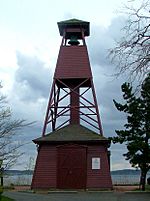Port Townsend, Washington facts for kids
Quick facts for kids
Port Townsend
|
|
|---|---|
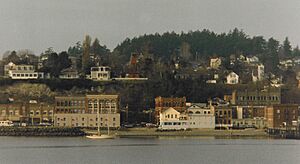
Downtown Port Townsend, seen from the water
|
|
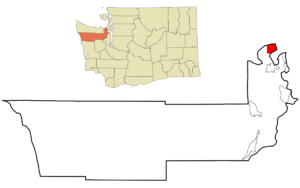
Location of Port Townsend, Washington
|
|
| Country | United States |
| State | Washington |
| County | Jefferson |
| Incorporated | 1851 |
| Government | |
| • Type | Council–manager |
| Area | |
| • Total | 7.35 sq mi (19.05 km2) |
| • Land | 6.94 sq mi (17.98 km2) |
| • Water | 0.41 sq mi (1.07 km2) |
| Elevation | 131 ft (40 m) |
| Population
(2020)
|
|
| • Total | 10,148 |
| • Density | 1,416.16/sq mi (546.75/km2) |
| Time zone | UTC−8 (Pacific (PST)) |
| • Summer (DST) | UTC−7 (Pacific Daylight Time) |
| ZIP code |
98368
|
| Area code(s) | 360 |
| FIPS code | 53-55855 |
| GNIS feature ID | 1524589 |
Port Townsend is a city located on the Quimper Peninsula in Jefferson County, Washington, United States. In 2020, about 10,148 people lived there. It is the main city and county seat of Jefferson County.
This city is famous for its beautiful natural views at the tip of the Olympic Peninsula. It also has many old Victorian buildings from the late 1800s. Port Townsend hosts many cultural events each year. It is also a key place for building boats and other sea-related businesses. The Port Townsend Historic District is a special area recognized as a U.S. National Historic Landmark District. The city gets less rain than nearby areas because it's in the rainshadow of the Olympic Mountains. It receives only about 19 inches (483 mm) of rain each year.
Contents
History of Port Townsend
The bay was first named "Port Townshend" in 1792 by Captain George Vancouver. He named it after his friend, the Marquis of Townshend. People quickly saw it as a safe harbor. However, strong winds and poor ground for anchors sometimes made it hard for small boats to stay in place.
The American city was officially started on April 24, 1851. In the mid-1800s, several Native American tribes lived in what is now Jefferson County. These included the Chimakum, Hoh, Klallam, Quinault, and Twana tribes.
Port Townsend is often called the "City of Dreams." This is because people in the early days thought it would become the biggest harbor on the west coast of the United States. Since it guards the entrance to Puget Sound, it also earned another nickname: the "Key City." This name is still used today.
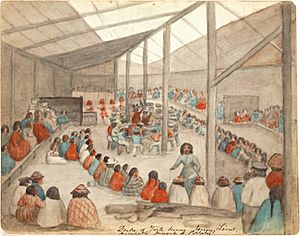
By the late 1800s, Port Townsend was a busy seaport. People were very hopeful about its future. Many homes and buildings were constructed during this time, often in a fancy Victorian style. The Port Townsend Police Department was also created in 1888.
Railroads were being built across the country in the 1870s to 1890s. Port Townsend was planned to be the end point for these rail lines in the northwest. Its large port was used by many ships from other countries. Shipping goods and timber was a big part of the economy. Many buildings were built because people believed Port Townsend would become a huge shipping hub and a major city.
However, when an economic downturn happened, these plans lost their funding. The main rail lines ended on the east side of Puget Sound, in cities like Tumwater, Tacoma, and Seattle. As other Puget Sound ports grew, Port Townsend's population quickly dropped. This happened because the Northern Pacific Railroad did not connect the city to Tacoma. By the late 1890s, the big boom was over. Without the railroad to help the economy grow, the town became smaller. Investors looked for opportunities elsewhere.
For many decades, Port Townsend found other ways to keep its economy stable. One way was by building artillery forts at Fort Worden. Many people left the area, and some buildings were left empty. The economy was very weak until the 1920s, when a paper mill was built near the town. Today, the bay is home to Naval Magazine Indian Island. This is the U.S. Navy's main dock for handling munitions on the Pacific coast.
Since the 1970s, new residents, including many retired people, have moved to Port Townsend. The shops along the waterfront now have restaurants, services, and places for tourists to visit. Since 1999, the city has hosted an international film festival every September. Other cultural events, some held at Fort Worden State Park, include a Wooden Boat Festival, a writers' conference, a playwriting festival, and blues and jazz festivals. There are also music, dance, and live theater shows. The town has two independent movie theaters.
Historic Buildings and Sites
Because the economy slowed down so quickly in the 1890s, very few of the Victorian buildings were torn down. They were kept safe for almost 100 years. Then, people realized how important it was to protect them. Unlike many cities in the Pacific Northwest that faced fires or earthquakes, Port Townsend has many well-preserved buildings. These include public, private, and business buildings from almost every time period in its history.
The Port Townsend Historic District includes many Victorian-era buildings. It was added to the National Register of Historic Places in 1976. It was then named a National Historic Landmark in 1977.
The Bell Tower is located on the bluff above downtown. It is one of only two known towers of its kind in the United States. From 1890 to the 1940s, it was used to call volunteer firefighters. The Jefferson County Historical Society restored it in 2003. The other similar bell tower is in Helena, Montana. It was also used for fire alarms in the late 1800s.
Geography and Climate
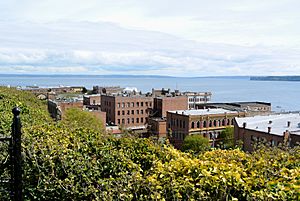
Port Townsend is located on the Quimper Peninsula. This peninsula stretches out from the far northeastern end of the Olympic Peninsula. The city sits at the north end of a large, partly protected bay. Port Townsend is next to the Admiralty Inlet. It is also near three state parks that were once military forts: Fort Worden, Fort Casey, and Fort Flagler. The city and its surrounding areas have many trees. Large Douglas fir trees are common in the wooded parts.
The city covers a total area of about 9.46 square miles (24.5 square kilometers). Of this, 6.98 square miles (18.1 square kilometers) is land. The remaining 2.48 square miles (6.4 square kilometers), or 26.22%, is water.
Weather in Port Townsend
Port Townsend has a mild Mediterranean climate. This means it has damp, cool winters that are not too harsh. Summers are warm and dry. The city is in the Olympic rain shadow. This causes it to receive only about 19.04 inches (484 mm) of rain each year. However, the area is not as dry as this number might suggest. Cool breezes and fog from the Juan de Fuca Strait help keep the air comfortably humid.
| Climate data for Port Townsend, Washington | |||||||||||||
|---|---|---|---|---|---|---|---|---|---|---|---|---|---|
| Month | Jan | Feb | Mar | Apr | May | Jun | Jul | Aug | Sep | Oct | Nov | Dec | Year |
| Record high °F (°C) | 62 (17) |
65 (18) |
74 (23) |
76 (24) |
90 (32) |
100 (38) |
100 (38) |
96 (36) |
90 (32) |
75 (24) |
68 (20) |
67 (19) |
100 (38) |
| Mean daily maximum °F (°C) | 46.4 (8.0) |
48.6 (9.2) |
52.1 (11.2) |
57.5 (14.2) |
63.1 (17.3) |
67.9 (19.9) |
72.6 (22.6) |
73.1 (22.8) |
68.0 (20.0) |
58.2 (14.6) |
50.1 (10.1) |
45.3 (7.4) |
58.6 (14.8) |
| Mean daily minimum °F (°C) | 38.4 (3.6) |
38.3 (3.5) |
40.3 (4.6) |
43.2 (6.2) |
47.2 (8.4) |
51.0 (10.6) |
53.0 (11.7) |
53.5 (11.9) |
51.0 (10.6) |
46.3 (7.9) |
41.3 (5.2) |
38.4 (3.6) |
45.2 (7.3) |
| Record low °F (°C) | 5 (−15) |
7 (−14) |
19 (−7) |
27 (−3) |
28 (−2) |
33 (1) |
33 (1) |
37 (3) |
35 (2) |
22 (−6) |
12 (−11) |
5 (−15) |
5 (−15) |
| Average precipitation inches (mm) | 2.24 (57) |
1.61 (41) |
1.85 (47) |
1.53 (39) |
1.52 (39) |
1.37 (35) |
0.73 (19) |
0.54 (14) |
1.10 (28) |
1.64 (42) |
2.43 (62) |
2.58 (66) |
19.14 (489) |
| Average snowfall inches (cm) | 0 (0) |
0.2 (0.51) |
0 (0) |
0 (0) |
0 (0) |
0 (0) |
0 (0) |
0 (0) |
0 (0) |
0 (0) |
0 (0) |
0.4 (1.0) |
0.6 (1.51) |
| Average precipitation days (≥ 0.01 inch) | 16 | 12.4 | 14.5 | 12.6 | 11.6 | 9.7 | 5.8 | 5.3 | 7.5 | 12 | 17 | 16.1 | 140.5 |
| Source 1: NOAA | |||||||||||||
| Source 2: NCDC | |||||||||||||
Population and People
| Historical population | |||
|---|---|---|---|
| Census | Pop. | %± | |
| 1880 | 917 | — | |
| 1890 | 4,558 | 397.1% | |
| 1900 | 3,443 | −24.5% | |
| 1910 | 4,181 | 21.4% | |
| 1920 | 2,847 | −31.9% | |
| 1930 | 3,979 | 39.8% | |
| 1940 | 4,683 | 17.7% | |
| 1950 | 6,888 | 47.1% | |
| 1960 | 5,074 | −26.3% | |
| 1970 | 5,241 | 3.3% | |
| 1980 | 6,067 | 15.8% | |
| 1990 | 7,001 | 15.4% | |
| 2000 | 8,334 | 19.0% | |
| 2010 | 9,113 | 9.3% | |
| 2020 | 10,148 | 11.4% | |
| 2023 (est.) | 10,502 | 15.2% | |
| U.S. Decennial Census | |||
2020 Census Information
In 2020, the city had 10,148 people. The population density was about 1,462 people per square mile (564 per square kilometer). There were 5,371 homes.
Most of the people (89.4%) were White. About 0.9% were African American, 0.6% were Native American, and 1.4% were Asian. About 4.2% of the people were from two or more races. People of Hispanic or Latino background made up 3.5% of the population.
About 11.1% of the population was under 18 years old. A large portion, 40.5%, was 65 years old or older. More than half of the population (54.6%) was female. About 4.8% of the people were born outside the U.S. Also, 9.7% of the population had served in the Armed Forces.
The average income for a household was $59,193. About 14.0% of the people lived below the poverty line.
Economy and Jobs
The biggest private employer in Port Townsend is the Port Townsend Paper Mill. Overall, the largest employer (including both private and public jobs) is Jefferson Healthcare. This organization runs Jefferson Healthcare Hospital. The main industries in the city include maritime trades (jobs related to the sea), manufacturing, tourism, and timber.
Arts and Culture
A sign welcoming people to Port Townsend calls it a "Victorian Seaport and Arts Community." This shows how important art and history are to the city.
Art and Music Scene
Many artists live in the Port Townsend area. Because of this, downtown has many art galleries and two groups run by artists. Northwind Art is a non-profit organization located in the old Waterman & Katz Building from 1885. There is a monthly Art Walk, where people can visit galleries. Many classes, workshops, and training programs for art are also available.
Fort Worden State Park is home to several cultural groups and places for events. Centrum is an arts organization that hosts many concerts, festivals, and workshops. These include events for "Fiddle Tunes," blues, jazz, singing, and chamber music. Copper Canyon Press, a poetry publisher, is also located there. Other groups at Fort Worden include Goddard College, Madrona Mindbody Institute, Peninsula College, and the Port Townsend School of Woodworking. In 1981, Fort Worden was a main filming spot for the 1982 movie An Officer And A Gentleman, starring Richard Gere.
Port Townsend has two dance schools for children and adults. The city is also home to the Port Townsend Symphony Orchestra.
Festivals and Events
Port Townsend hosts several events each year. These include the Port Townsend Wooden Boat festival, the Kinetic Skulpture Race (since 1983), the Rhododendron Festival, the Port Townsend Film Festival, and an annual blues and jazz festival.
Boating and life on the sea are very important in this port town. There are regattas (boat races), weekly races, and many fun activities on the water. Annual boating events include the Race to Alaska and Seventy48. The marine trades industry is a key part of the community's economy. It has highly skilled people who are known worldwide. The port is home to many classic wooden boats, and other boat owners visit for repairs.
Since 1999, Port Townsend has held its annual international film festival in September. The Rose Theatre downtown shows modern American and foreign movies. The Uptown Theater shows movies for families. A nearby drive-in theater is open during the summer. Key City Public Theatre is the local playhouse. It puts on many award-winning shows and performs Shakespeare in the Park in the summer.
In August 2019, Fort Worden started hosting a music festival called "THING." It was created by Adam Zacks, who also founded the Sasquatch! Music Festival. In 2023, Fleet Foxes, an indie-folk band from Seattle, was a main performer. Robin Pecknold, a famous musician from Port Townsend, leads this band. The THING festival will not return in 2024. This is because it was hard to get to the event due to Port Townsend's location. Also, there were not enough places to stay, and the festival did not make enough money.
Historical Buildings and Places
Port Townsend is known for its Victorian houses and important historical buildings. The city has more than a dozen large, well-kept buildings. These include the Port Townsend Public Library, which is a Carnegie Library built in 1913. The Federal Building, now the city's post office, is also notable. Other important buildings are the Rose Theatre and the Elks Lodge, which is now the Silverwater Cafe. Fort Worden, now a state park, still has some of its old buildings from before World War I. These were built when it was a military base. Some buildings have been changed for new uses. For example, the Jefferson County Courthouse is built in a Romanesque style. It has a 125-foot bell tower.
In 1976, the downtown waterfront and parts of Uptown were named a Registered Historic District. Later, Fort Worden (now part of Fort Worden State Park) and the City of Port Townsend were named National Historic Landmarks.
Environment and Wildlife
In 2022, the city council passed a resolution. This resolution stated that a local group of killer whales, called the Southern resident orcas, have "rights of nature." This means they should be protected. The council said the orcas are very important for the state's culture, spirit, and economy. The U.S. government has control over waters more than three miles offshore.
Education System
Public schools in Port Townsend are managed by the Port Townsend School District. This district includes Salish Coast Elementary School, Blue Heron Middle School, and Port Townsend High School.
Private schools in the city are Olympic Range Carden Academy and Swan School.
Adults can also find learning opportunities at Fort Worden. These are offered through Goddard College, Peninsula College, Centrum Foundation, Northwind Art, and the Port Townsend School of Woodworking.
City Infrastructure
State Route 20 goes southwest from Port Townsend for 13 miles (21 km). It connects to U.S. Route 101 at Discovery Bay. Port Angeles is 47 miles (76 km) west of Port Townsend by highway. Bremerton is 48 miles (77 km) to the south. Besides roads, you can reach the city using the Washington State Ferries system. There is a ferry route from Port Townsend to Coupeville on Whidbey Island.
Electric vehicle charging stations are available in several locations. You can find them at the Food Coop (414 Kearney Street), the Northwest Maritime Center (431 Water Street), and Safeway (442 W Sims Way).
Media and News
The community gets its news from two local sources. These are the Port Townsend & Jefferson County Leader and the Peninsula Daily News—Port Townsend/Jefferson County Edition. An online journal called Liberty Magazine is also based in the city.
Two radio stations are located in Port Townsend. KPTZ Radio Port Townsend, 91.9FM, focuses on education. KROH Radio of Hope, 91.1FM, plays Christian music.
The Netflix series "Dead Boy Detectives" was set in Port Townsend, WA.
Notable People
- Daniel James Brown, author
- Luke Burbank, radio host
- Frank Herbert, author of Dune
- Robin Pecknold, musician
- Annie Proulx, writer
- Marvin G. Shields, Medal of Honor, U.S. Navy, Vietnam War
- Jim Whittaker, mountaineer and first American to summit Mount Everest
- Wayne Bastrup, actor and musician
Sister Cities
Port Townsend is connected with Ichikawa, Hyōgo, Japan, as a sister city. A group of students from Port Townsend takes part in an exchange program with this Japanese city during the summer.
The Washington State Lieutenant Governor's website also lists Jalapa, Nicaragua, as a sister city. However, Port Townsend's own website does not mention this connection.
See also
 In Spanish: Port Townsend para niños
In Spanish: Port Townsend para niños


